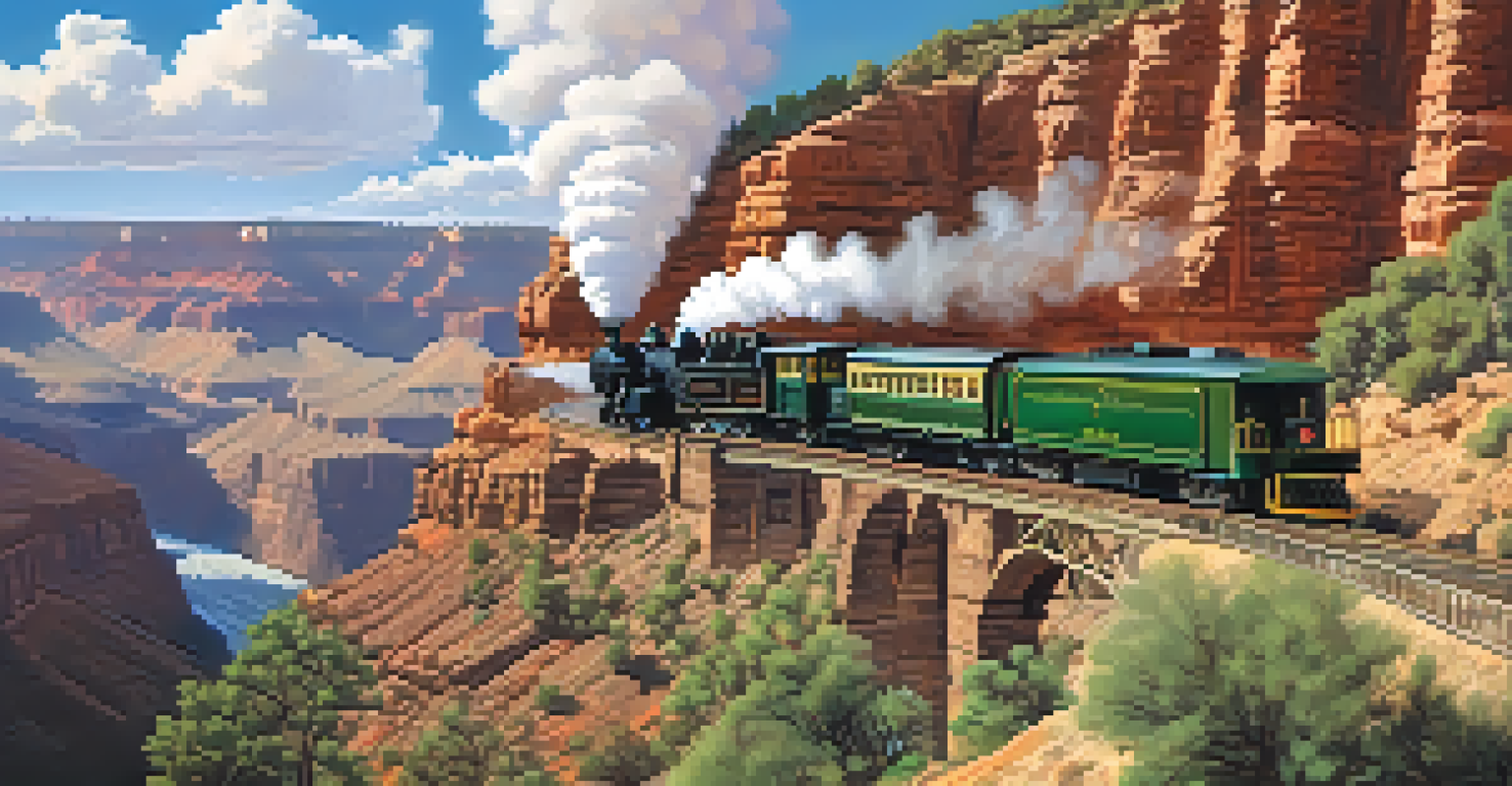Arizona's Historic Railroads: Tracks of the Past Uncovered

The Birth of Railroads in Arizona: A New Era Begins
In the late 1800s, railroads began to weave through Arizona, transforming the landscape and economy. The Southern Pacific Railroad was one of the first major lines, connecting cities and facilitating trade. This new mode of transport brought people and goods together, igniting growth in towns like Tucson and Phoenix.
The railroad is a great equalizer; it brings the far corner of a state into the center of its economy.
As railroads expanded, they played a pivotal role in the mining boom, transporting valuable minerals like copper and silver. The construction of the Santa Fe Railway in 1881 further opened up the region, allowing for increased commerce and migration. This burgeoning network not only connected Arizonans but also linked them to the rest of the nation.
The arrival of railroads marked a significant shift in Arizona’s development, turning remote areas into bustling hubs of activity. The influence of these early railroads is still felt today, as many of the routes laid down during this period continue to serve as vital transportation links.
Iconic Routes: The Santa Fe and Southern Pacific
Two of the most iconic railroads in Arizona's history are the Santa Fe and Southern Pacific. The Santa Fe Railway, with its distinctive red and yellow locomotives, became synonymous with the westward expansion. It opened up routes through picturesque landscapes, including the stunning Grand Canyon, making it a favorite among travelers.

Meanwhile, the Southern Pacific Railroad established critical connections between California and New Mexico, facilitating trade and travel across the Southwest. It not only transported goods but also brought in tourists eager to explore Arizona's natural beauty and cultural heritage. These railroads essentially laid the groundwork for Arizona’s tourism industry.
Railroads Transformed Arizona's Economy
In the late 1800s, the arrival of railroads like the Southern Pacific and Santa Fe facilitated commerce and mining, reshaping Arizona's economic landscape.
Today, remnants of these iconic routes can be seen in preserved stations and rail trails, which invite exploration and reflection. They serve as a reminder of a time when the sound of a train whistle symbolized opportunity and adventure.
The Role of Railroads in Arizona's Mining Industry
Arizona's rich mineral resources made it a hotspot for mining, and railroads were crucial in this booming industry. Railways facilitated the transport of copper, silver, and gold from remote mining camps to processing facilities and markets. This connection was essential for the growth and sustainability of mining operations throughout the state.
Railroads are a remarkable example of how technology can transform a society, creating connections that lead to growth and opportunity.
As mines expanded, so did the need for efficient transportation, leading to the establishment of narrow-gauge railroads. These smaller tracks navigated the rugged terrain and linked isolated mining operations to the main rail lines. This allowed for a more streamlined flow of resources, which in turn boosted the local economy.
The legacy of these mining railroads can still be seen in abandoned tracks and ghost towns scattered across Arizona. They tell a story of ambition and perseverance, capturing the spirit of the miners who relied on these railways to forge a better future.
Famous Train Stations: Architectural Marvels of the Past
Train stations in Arizona tell their own stories, showcasing unique architectural styles that reflect the era of their construction. The Tucson Depot, with its Mission Revival style, stands as a testament to the influence of Spanish architecture in the Southwest. It once buzzed with passengers and cargo, now serving as a historical landmark.
Another notable station is the Phoenix Union Station, which was a bustling hub during the early 20th century. Its grand design and intricate details made it a focal point for travelers. Today, while it no longer serves trains, it hosts events and offers a glimpse into the past.
Heritage Railroads Revive History
Heritage railroads in Arizona, such as the Grand Canyon Railway, offer nostalgic journeys while educating visitors about the state's rich railroad past.
These stations are not just structures; they embody the history and culture of Arizona's railroads. Preserving them is essential, as they provide a tangible link to a time when trains were the backbone of transportation and commerce.
The Decline of Railroads: Changes in Transportation
While railroads once dominated Arizona’s transportation landscape, the mid-20th century saw a decline in their prominence. The rise of automobiles and highways offered more flexibility and convenience for travel. As a result, many rail lines were abandoned or repurposed, leaving behind a trail of forgotten tracks.
This shift not only impacted passenger transport but also freight services. Trucking companies began to take over the delivery of goods, leading to a significant reduction in railroad revenue. Consequently, many historic train stations fell into disrepair, and train travel became less common.
However, the story of Arizona's railroads is not one of total decline. Efforts to revitalize and repurpose old tracks have emerged, promoting scenic railways for tourism and heritage purposes. This revival showcases a renewed interest in the history and charm of train travel.
Reviving the Past: Heritage Railroads and Tours
In recent years, Arizona has witnessed a resurgence in interest surrounding its railroad history, particularly through heritage railroads. These lines offer nostalgic rides through stunning landscapes, giving visitors a taste of what train travel was like in the past. The Grand Canyon Railway, for instance, provides a scenic journey from Williams to the South Rim, blending history with breathtaking views.
Heritage railroads not only preserve the technology and experience of early trains but also serve as educational platforms. Many of these railroads conduct tours that highlight the historical significance of their routes, sharing stories of the men and women who built and operated them. These experiences invite travelers to step back in time.
Railroad Museums Preserve Heritage
Arizona's railroad museums, like the Arizona Railway Museum, showcase the historical significance of railroads and their impact on the state's development.
As more people seek out unique travel experiences, heritage railroads play a crucial role in Arizona’s tourism landscape. They create a bridge between the past and present, allowing new generations to appreciate the rich history of railroads in the state.
Exploring Arizona's Railroad Museums: A Treasure Trove of History
Arizona is home to several railroad museums that preserve the state’s rich railroad heritage. The Arizona Railway Museum in Chandler, for instance, features an impressive collection of vintage locomotives and rolling stock. Visitors can explore exhibits that detail the evolution of rail travel and its impact on the state’s development.
The Southern Arizona Transportation Museum in Tucson is another gem, showcasing the history of railroads alongside other modes of transportation. Here, you can find artifacts, photographs, and interactive displays that bring the past to life. These museums serve as a reminder of the vital role railroads played in shaping Arizona’s identity.

By visiting these museums, you gain a deeper understanding of the challenges and triumphs of Arizona's railroad history. They not only preserve artifacts but also educate the public, ensuring that future generations appreciate the legacy of the tracks that once crisscrossed the state.